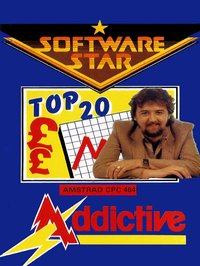Navigation:
Software Star Amstrad CPC
SOFTWARE STAR is the NEW game from Kevin Toms, who designed the Software Classic - FOOTBALL MANAGER. SOFTWARE STAR allows you to try your hand at running a successful software company. You have to cope with staff problems, game launches, advertising, financial problems, and more while trying to product chart topping successful games. One other thing, SOFTWARE STAR has that gripping Addictive quality that all Kevin's games have! — Cassette cover
Software Star is a 1985 game released by Kevin Toms for the Amstrad CPC, Commodore 64 and ZX Spectrum.
Gameplay
Essentially a text-based management game. The player's task is to manage a software house, create new games, manage his publicity and make a profit of £10000. Meanwhile, he must achieve the status of "Software Star" for ten successive months.
Having a large portfolio of games has its advantages by increasing the player's monthly sales. However, money must be spent on promoting aging titles. Each game has its own quality rating, where the quality increases with the amount of time spent on development. Managing the productivity of the player's staff is also key to the game, giving him a snapshot of the last six months. He could decide to either discipline offer incentives or take no action.
There are four sales regions where the player's products are sold. These regions are ordered from one to four, depending on how much importance he gives to them by consulting the sales from the previous month. Public relations also needs tweaking by choosing Honesty or Hype. Each decision has an effect on his company image. Finally, the player will have to evaluate his potential market depending on the time of year and decide how many advertising pages to buy. Markets are larger around Christmas and New Year. It is then time to sit back and look at the sales figures as the player's game enters the Top 20. He is then given a sales break even figure and each game climbs the chart if it sells well to the Number One spot.
At the end of the month the player views your monthly statement to check his progress and Stardom rating ranging from Nobody to Software Star. At the end of the year, the directors will check the player's progress. They will either fire him, raise the bar, or give him another chance.
Source:Wikipedia



